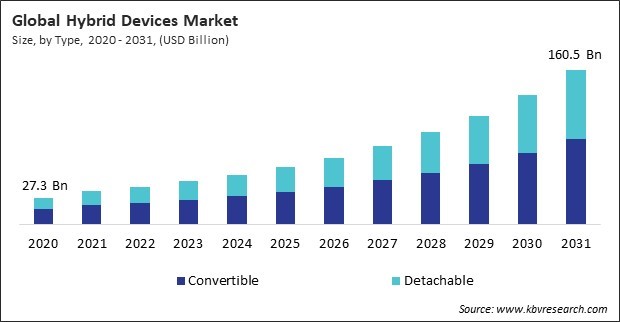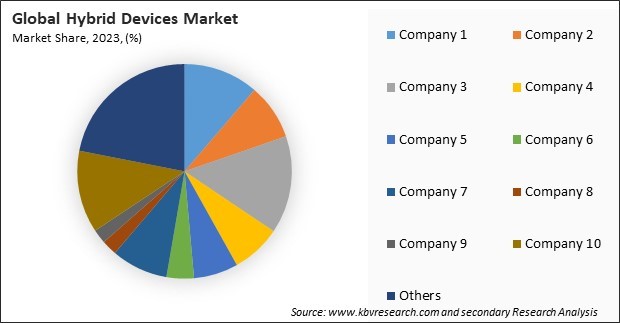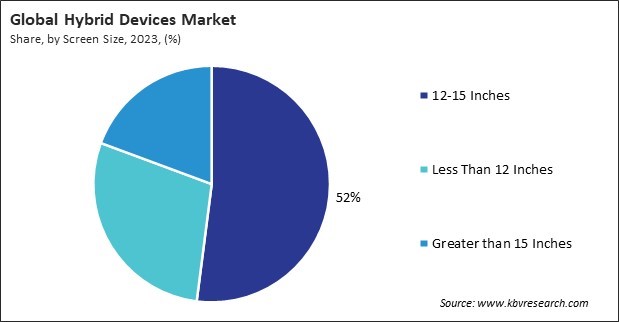“Global Hybrid Devices Market to reach a market value of 160.5 Billion by 2031 growing at a CAGR of 17.5%”
The Global Hybrid Devices Market size is expected to reach $160.5 billion by 2031, rising at a market growth of 17.5% CAGR during the forecast period.
The North America region witnessed 34% revenue share in the hybrid devices market in 2023. This significant share can be attributed to several factors, including the region’s strong technological infrastructure, high consumer demand for versatile computing solutions, and a robust presence of major manufacturers and technology companies. The increasing adoption of these devices in North America is further fuelled by trends such as remote work and digital transformation across various industries, with consumers and businesses seeking devices that can provide both portability and functionality.

Today’s consumers seek devices that can adapt to various use cases. Whether for work, entertainment, education, or communication, performing multiple functions within a single device is increasingly attractive. These devices, which combine features of laptops, tablets, and smartphones, cater to this need by offering flexibility and convenience. This versatility allows users to switch between different tasks seamlessly, making these devices a preferred choice for many. In conclusion, the rising demand for versatile technology solutions drives the market's growth.
Additionally, As remote work and learning become commonplace, there is a growing demand for devices that can perform multiple functions efficiently. These devices, which blend the capabilities of laptops and tablets, provide the versatility needed for various tasks—from video conferencing and document editing to online research and creative projects. This adaptability makes them particularly appealing to professionals and students requiring a single device to meet all their needs. Therefore, remote work and learning environments are propelling the market's growth.
However, these devices, such as standard laptops or tablets, often come with a higher price tag than their traditional counterparts. This premium pricing is typically due to their advanced technology, multifunctionality, and the integration of various features. The initial cost can be a major barrier to adoption for budget-conscious consumers and small businesses, leading them to opt for more affordable, single-function devices instead. Thus, high initial costs and price sensitivity impede the market's growth.

The leading players in the market are competing with diverse innovative offerings to remain competitive in the market. The above illustration shows the percentage of revenue shared by some of the leading companies in the market. The leading players of the market are adopting various strategies in order to cater demand coming from the different industries. The key developmental strategies in the market are Acquisitions, and Partnerships & Collaborations.
Based on type, the hybrid devices market is divided into convertible and detachable. The detachable segment attained 43% revenue share in this market in 2023. Detachable devices are designed with a keyboard that can be completely removed from the screen, allowing the device to function as a standalone tablet. This design appeals to users prioritizing portability and touch interaction, particularly for media consumption, notetaking, and casual browsing.
On the basis of screen size, the hybrid devices market is segmented into 12-15 inches, less than 12 inches, and greater than 15 inches. In 2023, the less than 12 inches segment attained 29% revenue share in this market. Devices in this category are favoured for their ultra-portability and lightweight design, making them ideal for on-the-go professionals, students, and casual users. While these smaller devices may have limited performance capabilities compared to their larger counterparts, they excel in convenience and ease of use for tasks such as browsing, notetaking, and media consumption.

Based on end user, the hybrid devices market is categorized into IT & telecom, personal use, educational institutions, healthcare, and others. The personal use segment witnessed 25% revenue share in this market in 2023. This segment encompasses a diverse range of consumers who seek devices that combine the functionalities of laptops and tablets for various everyday tasks. Personal use these devices are particularly popular for browsing, streaming, and light productivity tasks, appealing to users who value convenience and versatility. With lifestyle changes and an increasing preference for mobile computing, personal use devices have gained traction among a broad audience, from students and professionals to casual users.
Free Valuable Insights: Global Hybrid Devices Market size to reach USD 160.5 Billion by 2031
Region-wise, the hybrid devices market is analyzed across North America, Europe, Asia Pacific, and LAMEA. In 2023, the Europe region generated 32% revenue share in this market. This market performance reflects Europe’s growing emphasis on digitalization and technology integration into everyday life and business practices. European consumers increasingly seek flexible devices, especially in remote work and mobile learning environments. The rise of these devices in educational institutions across Europe has also played a crucial role in driving market growth as schools and universities adopt these tools to enhance the learning experience.
| Report Attribute | Details |
|---|---|
| Market size value in 2023 | USD 45.1 Billion |
| Market size forecast in 2031 | USD 160.5 Billion |
| Base Year | 2023 |
| Historical Period | 2020 to 2022 |
| Forecast Period | 2024 to 2031 |
| Revenue Growth Rate | CAGR of 17.5% from 2024 to 2031 |
| Number of Pages | 248 |
| Tables | 360 |
| Report coverage | Market Trends, Revenue Estimation and Forecast, Segmentation Analysis, Regional and Country Breakdown, Market Share Analysis, Porter’s 5 Forces Analysis, Company Profiling, Companies Strategic Developments, SWOT Analysis, Winning Imperatives |
| Segments covered | Type, Screen Size, End User, Region |
| Country scope |
|
| Companies Included | Dell Technologies, Inc., Lenovo Group Limited, Microsoft Corporation, Toshiba Corporation, Fujitsu Limited, LG Electronics, Inc. (LG Corporation), Samsung Electronics Co., Ltd. (Samsung Group), Acer Inc., ASUSTeK Computer Inc., and Hewlett-Packard enterprise Company (HP Development Company L.P.) |
By Type
By Screen Size
By End User
By Geography
The Market size is projected to reach USD 160.5 billion by 2031.
Rising Demand For Versatile Technology Solutions are driving the Market in coming years, however, High Initial Costs And Price Sensitivity restraints the growth of the Market.
Dell Technologies, Inc., Lenovo Group Limited, Microsoft Corporation, Toshiba Corporation, Fujitsu Limited, LG Electronics, Inc. (LG Corporation), Samsung Electronics Co., Ltd. (Samsung Group), Acer Inc., ASUSTeK Computer Inc., and Hewlett-Packard enterprise Company (HP Development Company L.P.)
The expected CAGR of this Market is 17.5% from 2024 to 2031.
The 12-15 Inches segment led the maximum revenue in the Market by Screen Size in 2023, thereby, achieving a market value of $80.4 billion by 2031.
The North America region dominated the Market by Region in 2023, and would continue to be a dominant market till 2031; thereby, achieving a market value of $52.6 billion by 2031.
Our team of dedicated experts can provide you with attractive expansion opportunities for your business.

 Drivers
Drivers
 Restraints
Restraints
 Opportunities
Opportunities
 Challenges
Challenges
